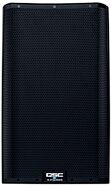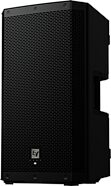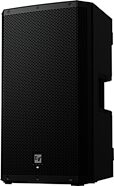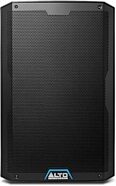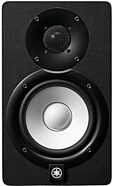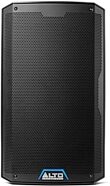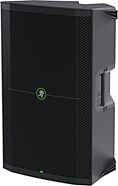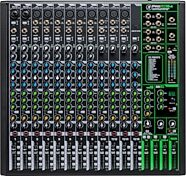
Mackie ProFX16v3 Professional USB Mixer, 16-Channel
THE workhorse compact mixer! Mackie's 3rd-gen ProFX16 gives you 11 Onyx mic preamps, one-knob compressors on 8 channels, 2x4 USB I/O and 24 built-in effects!
$549.99
- 8 x$68.75
- No Credit Check6 x$91.66
- No Credit Check4 x$137.50
Mackie CFX12 Compact Mixer with Effects (12x4x1)
No longer available at zZounds
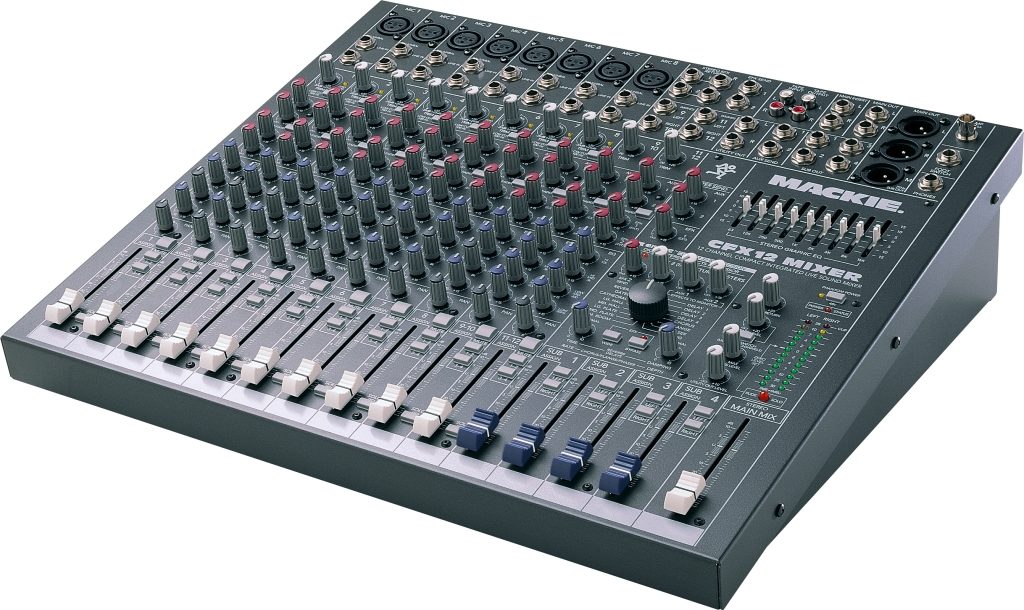


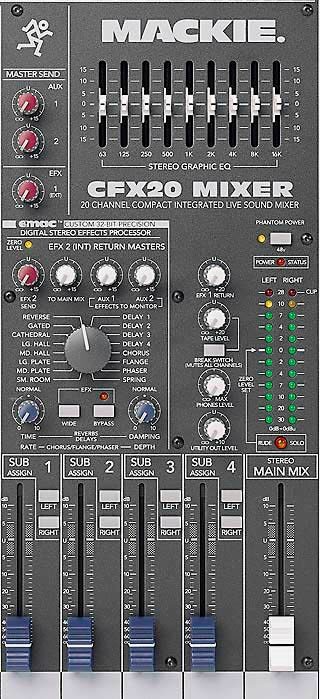
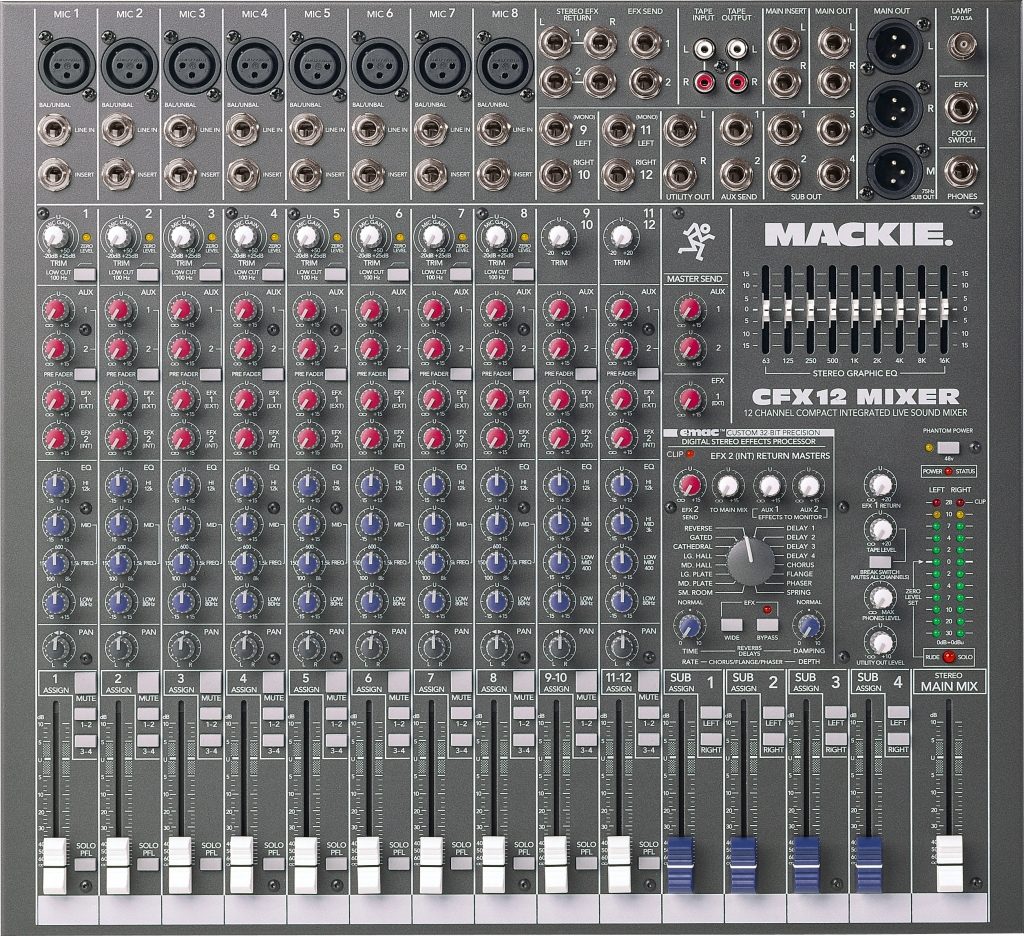
zZounds Gear Experts Say...
Mixer. Digital effects. EQ.
Overview
The new CFX Series are the first "effects" mixers that meet Greg Mackie's stringent standards for sound quality, low noise and high headroom.
Mackie's Digital Engineering staff contributed sophisticated EMAC 32-bit digital effects that are the equal of outboard processors. They spent a ridiculous amount of time perfecting a graphic EQ section. And they packed the CFX Series mic/line mixers with extra features.
CFX12 Features
High-headroom mic preamps with RF rejection
12 channels (8 mic/line mono, and 2 stereo line channels)
32-bit EMAC digital effects with 9 reverbs, 4 delays, phaser, chorus, flange; 2 parameter controls + EFX wide spatial expander
External and internal EFX sends
EFX to Monitor control
9-band stereo graphic equalizer
Inserts on all mic channels and main mix
True 4-bus design with direct sub outs and L/R assign
2 Pre/Post Aux sends and internal/external FX level sends on each channel
3-band EQ with swept mid (100Hz to 8kHZ) on mic/line channels
4-band EQ on stereo line channels
Pan, Mute, PFL solo on each channel
Inserts and 100Hz low-cut filters on all mic/line channels
Subwoofer output from built-in 18dB/oct. 75Hz crossover
Ingenious BREAK switch
Headphone output with level control
Tape/CD inputs with level control assignable to Main Mix via Break switch
Logarithmic taper 60mm faders
48V phantom power
12V BNC lamp jack
CFX Series Features
16 digital effects with 32-bit internal EMAC processing - 2… read more adjustable parameters
Studio-quality, 9-band stereo graphic program equalizer. Bottom line: CFX mixers' graphic EQs are exceptionally low-noise, low-distortion, and don't suffer from any nasty phase-shift problems
Level-setting LED for each channel
Trim Control with 50dB of mic gain (for timid vocalists or low-output mics. +30dB of line level gain and a full 15dB of attenuation to "pad" hot signals
Inserts on all mic channels and mains
Aux Sends, switchable to pre-fader for monitor use
External and internal EFX Sends
12kHz shelving High frequency EQ
Sweepable peaking Midrange EQ (only on mono input channels). Ultra-wide 100Hz to 8kHz bandwidth lets you use this control as an extra LF or HF EQ, too
80Hz shelving Low frequency EQ
Pre-Fader Solo switch lets you monitor the channel via headphones. It's also the key to fast, accurate level setting. Just press Solo and adjust the channel's trim control until the Zero Level LED flickers. You've now maximized headroom and minimized noise for the channel in a matter of seconds
Subgroup buses "collect" channel signals assigned to them so you can submix vocals, drums, nose flute quartets, etc.
Mondo-nifty Break Switch mutes all channels (and routes Tape input to the mains) while you're on break so you don't have to worry about feedback or some idiot grabbing a mic for an impromptu poetry reading
The Rude Solo Light that made us what we are today. (Whatever that is.)
Tape Level Control.
12V BNC lamp socket
RCA-type unbalanced tape/CD inputs and tape outputs
Balanced/unbalanced 1/4" TRS and balanced XLR outputs for mains
Headphone jack with level control
Subwoofer output from built-in 18dB/oct. 75Hz crossover!
Extra Utility Outputs with their own level control (post-Main Fader)
Long-wearing 60mm logarithmic taper faders give you smooth, linear control throughout the fader's entire travel
Solid steel chassis is punched bent and painted by gigantic automated machines supervised by medium-sized, non-automated Mackoids
On the back: built-in power supply (instead of an outlet-eating wall wart) uses easily-replaceable standard IEC line cord read less
Mackie's Digital Engineering staff contributed sophisticated EMAC 32-bit digital effects that are the equal of outboard processors. They spent a ridiculous amount of time perfecting a graphic EQ section. And they packed the CFX Series mic/line mixers with extra features.
CFX12 Features
High-headroom mic preamps with RF rejection
12 channels (8 mic/line mono, and 2 stereo line channels)
32-bit EMAC digital effects with 9 reverbs, 4 delays, phaser, chorus, flange; 2 parameter controls + EFX wide spatial expander
External and internal EFX sends
EFX to Monitor control
9-band stereo graphic equalizer
Inserts on all mic channels and main mix
True 4-bus design with direct sub outs and L/R assign
2 Pre/Post Aux sends and internal/external FX level sends on each channel
3-band EQ with swept mid (100Hz to 8kHZ) on mic/line channels
4-band EQ on stereo line channels
Pan, Mute, PFL solo on each channel
Inserts and 100Hz low-cut filters on all mic/line channels
Subwoofer output from built-in 18dB/oct. 75Hz crossover
Ingenious BREAK switch
Headphone output with level control
Tape/CD inputs with level control assignable to Main Mix via Break switch
Logarithmic taper 60mm faders
48V phantom power
12V BNC lamp jack
CFX Series Features
16 digital effects with 32-bit internal EMAC processing - 2… read more adjustable parameters
Studio-quality, 9-band stereo graphic program equalizer. Bottom line: CFX mixers' graphic EQs are exceptionally low-noise, low-distortion, and don't suffer from any nasty phase-shift problems
Level-setting LED for each channel
Trim Control with 50dB of mic gain (for timid vocalists or low-output mics. +30dB of line level gain and a full 15dB of attenuation to "pad" hot signals
Inserts on all mic channels and mains
Aux Sends, switchable to pre-fader for monitor use
External and internal EFX Sends
12kHz shelving High frequency EQ
Sweepable peaking Midrange EQ (only on mono input channels). Ultra-wide 100Hz to 8kHz bandwidth lets you use this control as an extra LF or HF EQ, too
80Hz shelving Low frequency EQ
Pre-Fader Solo switch lets you monitor the channel via headphones. It's also the key to fast, accurate level setting. Just press Solo and adjust the channel's trim control until the Zero Level LED flickers. You've now maximized headroom and minimized noise for the channel in a matter of seconds
Subgroup buses "collect" channel signals assigned to them so you can submix vocals, drums, nose flute quartets, etc.
Mondo-nifty Break Switch mutes all channels (and routes Tape input to the mains) while you're on break so you don't have to worry about feedback or some idiot grabbing a mic for an impromptu poetry reading
The Rude Solo Light that made us what we are today. (Whatever that is.)
Tape Level Control.
12V BNC lamp socket
RCA-type unbalanced tape/CD inputs and tape outputs
Balanced/unbalanced 1/4" TRS and balanced XLR outputs for mains
Headphone jack with level control
Subwoofer output from built-in 18dB/oct. 75Hz crossover!
Extra Utility Outputs with their own level control (post-Main Fader)
Long-wearing 60mm logarithmic taper faders give you smooth, linear control throughout the fader's entire travel
Solid steel chassis is punched bent and painted by gigantic automated machines supervised by medium-sized, non-automated Mackoids
On the back: built-in power supply (instead of an outlet-eating wall wart) uses easily-replaceable standard IEC line cord read less
Specs
Frequency Response
Mic Input to any Output Trim at 0 dB
32Hz to 20kHz: +0, -1 dB,
Distortion
THD and SMPTE IMD; 20Hz to 20kHz
Mic Input to Main Output: < 0.05% at +4 dBu output
Noise
20Hz to 20kHz BW (150 Ohms source impedance)
Equivalent Input Noise (EIN): -127 dBu
Residual Output Noise Main, Monitor, and Effects outputs Channel and Master levels off: -95 dBu
Common Mode Rejection Ratio (CMRR)
at 1kHz, Trim at 0 dB 60 dB
Crosstalk
Adjacent Inputs or Input to Output: -90 dB at 1kHz
Fader Off: -90 dB at 1kHz
Mute Switch and Break Switch Mute: -80 dB at 1kHz
Input Level Trim Control Range
+6 to -50dB
Phantom Power
+48V DC
Equalization
Low Cut: 100Hz, -18dB/octave
Mono Channel EQ High: ±15dB at 12kHz
Mono Channel EQ Mid: ±15 dB at 100Hz to 8kHz
Mono Channel EQ Low: ±15 dB at 80Hz
Stereo Channel EQ High: ±15 dB at 12kHz
Stereo Channel EQ High Mid: ±15 dB at 3kHz
Stereo Channel EQ Low Mid: ±15 dB at 400Hz
Stereo Channel EQ Low: ±15 dB at 80Hz
Graphic EQ (9 bands): ±15 dB, Q =1.414: ISO octave centers at 63Hz, 125Hz, 250Hz, 500Hz, 1k, 2k, 4k, 8k, 16kHz
Mixer Rated Output
Main, Sub, Aux, & Efx: +4 dBu
Maximum Rated Output: +20 dBu
Maximum Input Levels
Mic input Trim at +6 dB: +18 dBu
Line Input Trim at -15 dB: +38 dBu
Insert Return, Stereo Line Input, Tape Input, and Effects Return: +20 dBu
Maximum Voltage Gain
Mic input to Insert Output: 50 dB
Mic input to Tape Output: 66 dB
Mic input to Sub Output: 66 dB
Mic input to Main Output: 76 dB
Mic input to Aux Send: 71 dB
Line Input to Insert Output: 30 dB
Line Input to Tape Output: 46 dB
Line Input to Sub Output: 46 dB
Line Input to Main Output: 56 dB
Line Input to Aux Send: 51 dB
Stereo Line Input to Tape Output: 40 dB
Stereo Line Input to Sub Output: 40 dB
Stereo Line Input to Main Output: 50 dB
Stereo Line Input to Aux Send: 45 dB
Tape Input to Main Output: 30 dB
Effects Return to Main Output: 30 dB
Input Impedance
Mic Input: 3 kilohms, balanced
Line Input: 40 kilohms, balanced
Insert Return, Stereo Line Input, Tape Input, and Effects Returns: 10 kilohms, unbalanced
Output Impedance
Main Output, Insert Output, Tape Output, Sub Output, and Effects Sends: 150 Ohms
Digital Effects
Resolution: 32-bit EMAC processing, 2-channel
Number of Presets: 16
Parameters: 2 controllable
Channel Level Set LED (Sensitivity)
0 dBu (normal operating level)
VU Meters
Main L/R 12 segments: Clip, +10, +7, +4, +2, 0, -2, -4, -7, -10, -20, -30
Weight: 17.8 lbs. (8.1 kg)
Mic Input to any Output Trim at 0 dB
32Hz to 20kHz: +0, -1 dB,
Distortion
THD and SMPTE IMD; 20Hz to 20kHz
Mic Input to Main Output: < 0.05% at +4 dBu output
Noise
20Hz to 20kHz BW (150 Ohms source impedance)
Equivalent Input Noise (EIN): -127 dBu
Residual Output Noise Main, Monitor, and Effects outputs Channel and Master levels off: -95 dBu
Common Mode Rejection Ratio (CMRR)
at 1kHz, Trim at 0 dB 60 dB
Crosstalk
Adjacent Inputs or Input to Output: -90 dB at 1kHz
Fader Off: -90 dB at 1kHz
Mute Switch and Break Switch Mute: -80 dB at 1kHz
Input Level Trim Control Range
+6 to -50dB
Phantom Power
+48V DC
Equalization
Low Cut: 100Hz, -18dB/octave
Mono Channel EQ High: ±15dB at 12kHz
Mono Channel EQ Mid: ±15 dB at 100Hz to 8kHz
Mono Channel EQ Low: ±15 dB at 80Hz
Stereo Channel EQ High: ±15 dB at 12kHz
Stereo Channel EQ High Mid: ±15 dB at 3kHz
Stereo Channel EQ Low Mid: ±15 dB at 400Hz
Stereo Channel EQ Low: ±15 dB at 80Hz
Graphic EQ (9 bands): ±15 dB, Q =1.414: ISO octave centers at 63Hz, 125Hz, 250Hz, 500Hz, 1k, 2k, 4k, 8k, 16kHz
Mixer Rated Output
Main, Sub, Aux, & Efx: +4 dBu
Maximum Rated Output: +20 dBu
Maximum Input Levels
Mic input Trim at +6 dB: +18 dBu
Line Input Trim at -15 dB: +38 dBu
Insert Return, Stereo Line Input, Tape Input, and Effects Return: +20 dBu
Maximum Voltage Gain
Mic input to Insert Output: 50 dB
Mic input to Tape Output: 66 dB
Mic input to Sub Output: 66 dB
Mic input to Main Output: 76 dB
Mic input to Aux Send: 71 dB
Line Input to Insert Output: 30 dB
Line Input to Tape Output: 46 dB
Line Input to Sub Output: 46 dB
Line Input to Main Output: 56 dB
Line Input to Aux Send: 51 dB
Stereo Line Input to Tape Output: 40 dB
Stereo Line Input to Sub Output: 40 dB
Stereo Line Input to Main Output: 50 dB
Stereo Line Input to Aux Send: 45 dB
Tape Input to Main Output: 30 dB
Effects Return to Main Output: 30 dB
Input Impedance
Mic Input: 3 kilohms, balanced
Line Input: 40 kilohms, balanced
Insert Return, Stereo Line Input, Tape Input, and Effects Returns: 10 kilohms, unbalanced
Output Impedance
Main Output, Insert Output, Tape Output, Sub Output, and Effects Sends: 150 Ohms
Digital Effects
Resolution: 32-bit EMAC processing, 2-channel
Number of Presets: 16
Parameters: 2 controllable
Channel Level Set LED (Sensitivity)
0 dBu (normal operating level)
VU Meters
Main L/R 12 segments: Clip, +10, +7, +4, +2, 0, -2, -4, -7, -10, -20, -30
Weight: 17.8 lbs. (8.1 kg)
Documents and Manuals
For support or warranty questions, please contact the manufacturer:
Phone: 800-898-3211
Email: support@mackie.com
Web: https://mackie.com/en/support/contact
Phone: 800-898-3211
Email: support@mackie.com
Web: https://mackie.com/en/support/contact
Reviews
Reviewers gave this product an overall rating of 5 out of 5 stars.
(54 ratings)
Submitted February 21, 2006 by a customer from hotmail.com
"If you want a 16 channel mixer buy a mixer, if you want a 16 channel mixer with an FX loop get this one."
Verified Customer
zZounds has verified that this reviewer made a purchase from us.
I suspect that I will always have use for this product--If I need more channels for some applications I might find myself getting a bigger mixer, but I would always go back to using this for Jam sessions or small applications, (or at least that is what I think now, I certainly do not know what the bigger mixer would sound like).
Sound
I would characterize the sound of this product as clean and honest. The EQ's are good, (the channels' and the graphic) and provide many sweet settings. I can run my electric basses, electric/acoustic basses and upright bass through this mixer and get great awesome sound for all of them. Thus far I've only used this mixer in a studio setting; I run it's left and right signals into a 500 watt sony amplifier/reciever and run two 3-way speakers, (2", 4" and 15"), I use its effects send/Receive loop for a chorus pedal for the electric bass, as I preferr to use the on board FX for the reverb, (their are a few nice reverb settings on the board, the reverb on the board is nice too, it is just that I want chorus on the bass and reverb on the voices). Through my system this mixer is brutally honest, allowing me to refine the subtleties in tone and tembre of my voice. The first time I used it I was humbled by the tembre of my voice, however it only took a few minutes for my ear and vocal chords to clean up what I was hearing--The point is THE MIXER IS HONEST. I usually use ampeg and GK amplifiers for my bass, but I… read more do not bother at home anymore b/c this mixer serves me fine--unless I have to revisit the relationship of my specific bass with one of my amplifiers I only use the mixer in my home-studio as it boasts all the sound I need for rehearsal, practice and learning. My amplifier/speaker system is make-shift because my wallet does not have more money. I would like to run some powerred speakers out of this board, as well as a sub. I am looking at Mackie and JBL for that purpose but I remain undecided at this point. a pair of Mackie SRM450 Mackie SRM350 JBL EON15 G2 JBL EON 15P and I donno about sub
Features
I admit that my experience in mixing is limitted now to this product and a Yorkville 6 channel mixer, (I do not even know its product #, but the mackie is in an entirely different league). I researched mixers for several months before I committed to this one, (I've owned it for a year now that I am writing this). This mixer has 4 more channels than I see myself needing for the present time, but the FX loop on this product and the room to expand warrented my not buying an 8 channel mixer, and spending a bit extra on this product. As I play in a dixie band for a guy who uses a Mackie 8 channel mixer with some other mysterie FX box I notice a huge difference in the FX he has compared to my board; his reverb sounds raw and mechanical--very digitized; my reverb settings all sound smooth and warm. I got what I expected; I got what I wanted with this mixer.
Ease of Use
The owner's manuel is GOLD. As I said above I had limmitted experience mixing, and although many features of the board are intuitive, (the rude solo light was not...) their were many subtleties suggested, (low end cuts, and the like to cut down vocal pops) in the manual that gave me stellar results I think faster than I would of had them had I just explored the product using my intuition. In short I think a person is foolish to think a mixer is easy to use well, (mixing is a skill--requiring a great deal of musicianship), this mixer is working well for me.
Quality
This is a nicely finished steel box with knobs, sliders and switches, all of them are clean and visable, the power chord is like one of a PC, and is included the rubber feet on the base ensure that it wont vibrate sympathetically with the low end frequencies I drive. I do not worry about this piece, I figure I will own it forever. As with all products that use those PC like power chords I wish they would have an appropriately sized cavity on the outside of the product for the chord to be stuffed in when in transit--but that is just me, the industry seems to disagree.
Value
For a high quality mixer and this FX loop nothing touches the value of this product. I recommended it to my father as he was courting a mixer for a church and studio based application, and a week later he bought it, and tells me he's been pleased since
Manufacturer Support
Ok--I put 10, but really I do not know--I haven't needed to call them.
The Wow Factor
I own it and I am not getting rid of it.
Musical Background:
Active musician, bass and vocals
Musical Style:
Jazz, contemporary christian read less
Sound
I would characterize the sound of this product as clean and honest. The EQ's are good, (the channels' and the graphic) and provide many sweet settings. I can run my electric basses, electric/acoustic basses and upright bass through this mixer and get great awesome sound for all of them. Thus far I've only used this mixer in a studio setting; I run it's left and right signals into a 500 watt sony amplifier/reciever and run two 3-way speakers, (2", 4" and 15"), I use its effects send/Receive loop for a chorus pedal for the electric bass, as I preferr to use the on board FX for the reverb, (their are a few nice reverb settings on the board, the reverb on the board is nice too, it is just that I want chorus on the bass and reverb on the voices). Through my system this mixer is brutally honest, allowing me to refine the subtleties in tone and tembre of my voice. The first time I used it I was humbled by the tembre of my voice, however it only took a few minutes for my ear and vocal chords to clean up what I was hearing--The point is THE MIXER IS HONEST. I usually use ampeg and GK amplifiers for my bass, but I… read more do not bother at home anymore b/c this mixer serves me fine--unless I have to revisit the relationship of my specific bass with one of my amplifiers I only use the mixer in my home-studio as it boasts all the sound I need for rehearsal, practice and learning. My amplifier/speaker system is make-shift because my wallet does not have more money. I would like to run some powerred speakers out of this board, as well as a sub. I am looking at Mackie and JBL for that purpose but I remain undecided at this point. a pair of Mackie SRM450 Mackie SRM350 JBL EON15 G2 JBL EON 15P and I donno about sub
Features
I admit that my experience in mixing is limitted now to this product and a Yorkville 6 channel mixer, (I do not even know its product #, but the mackie is in an entirely different league). I researched mixers for several months before I committed to this one, (I've owned it for a year now that I am writing this). This mixer has 4 more channels than I see myself needing for the present time, but the FX loop on this product and the room to expand warrented my not buying an 8 channel mixer, and spending a bit extra on this product. As I play in a dixie band for a guy who uses a Mackie 8 channel mixer with some other mysterie FX box I notice a huge difference in the FX he has compared to my board; his reverb sounds raw and mechanical--very digitized; my reverb settings all sound smooth and warm. I got what I expected; I got what I wanted with this mixer.
Ease of Use
The owner's manuel is GOLD. As I said above I had limmitted experience mixing, and although many features of the board are intuitive, (the rude solo light was not...) their were many subtleties suggested, (low end cuts, and the like to cut down vocal pops) in the manual that gave me stellar results I think faster than I would of had them had I just explored the product using my intuition. In short I think a person is foolish to think a mixer is easy to use well, (mixing is a skill--requiring a great deal of musicianship), this mixer is working well for me.
Quality
This is a nicely finished steel box with knobs, sliders and switches, all of them are clean and visable, the power chord is like one of a PC, and is included the rubber feet on the base ensure that it wont vibrate sympathetically with the low end frequencies I drive. I do not worry about this piece, I figure I will own it forever. As with all products that use those PC like power chords I wish they would have an appropriately sized cavity on the outside of the product for the chord to be stuffed in when in transit--but that is just me, the industry seems to disagree.
Value
For a high quality mixer and this FX loop nothing touches the value of this product. I recommended it to my father as he was courting a mixer for a church and studio based application, and a week later he bought it, and tells me he's been pleased since
Manufacturer Support
Ok--I put 10, but really I do not know--I haven't needed to call them.
The Wow Factor
I own it and I am not getting rid of it.
Musical Background:
Active musician, bass and vocals
Musical Style:
Jazz, contemporary christian read less
5 of 6 people (83%) people found this review helpful. Did you?
Thanks for your opinion!
No longer available at zZounds
This is a carousel with product cards. Use the previous and next buttons to navigate.






